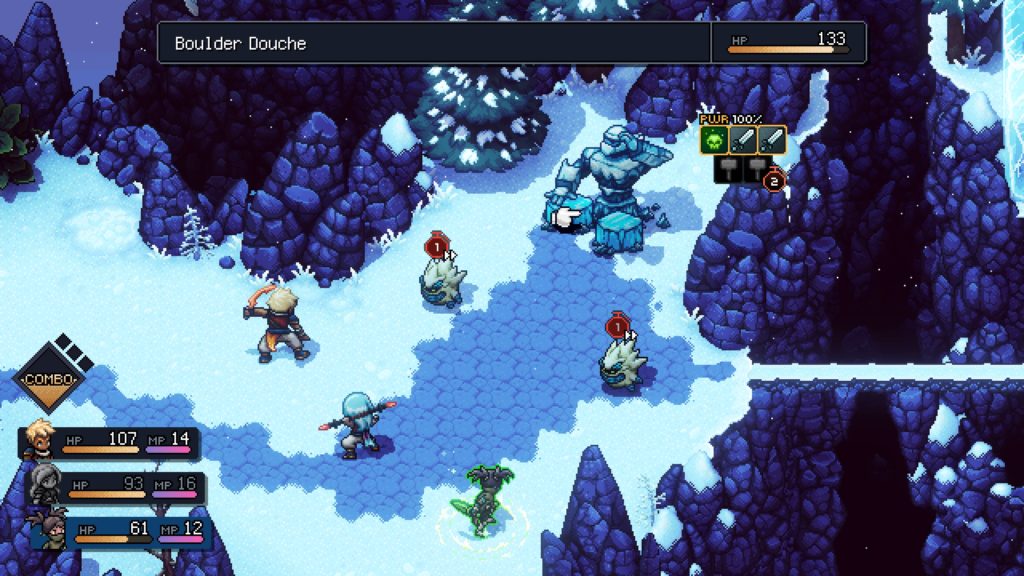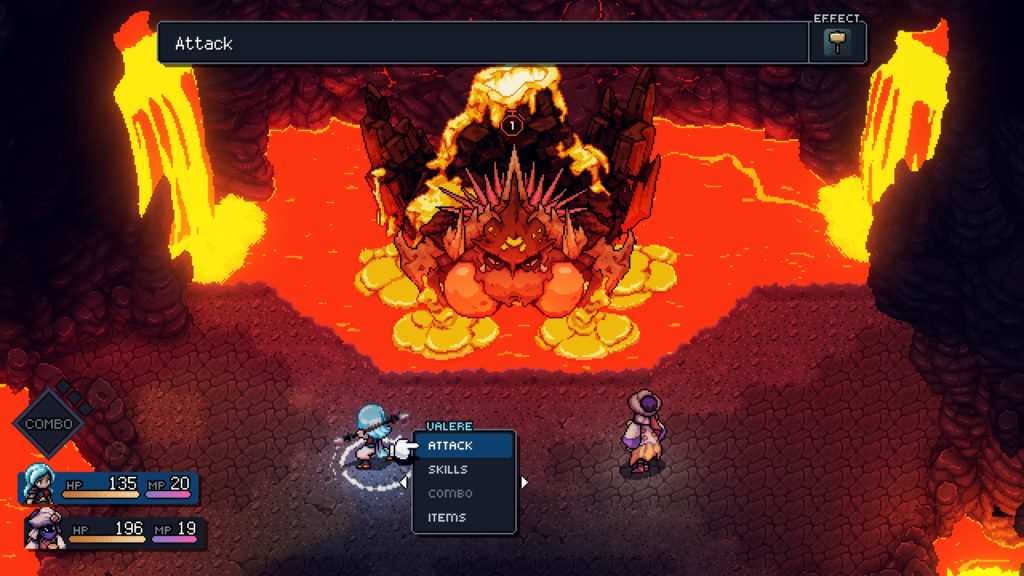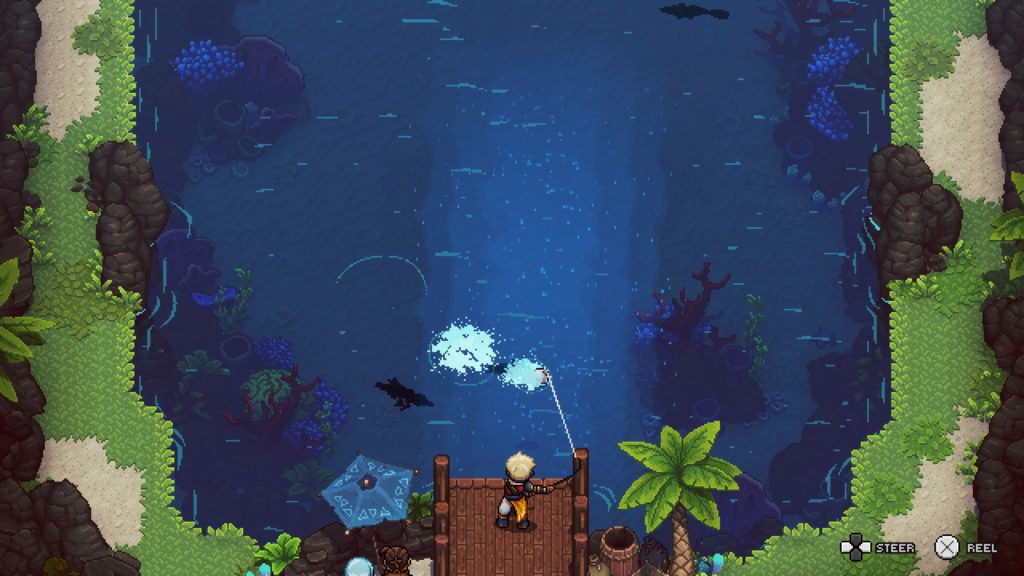More Info from Sabotage Studio
- Genre: JRPG
- Platform: PS5
- Also Available On: Windows, Switch, PS4, Xbox One, Xbox Series
This is an interesting game, not the least of which is because it’s distinctly a JRPG not developed in Japan. It very clearly takes inspiration from games like Chrono Trigger, with which it shares a composer. It also clearly leans into games like Suikoden, FF6, and Lufia. However, the one it really brings to mind to me more than any of those is Super Mario RPG.
It was pretty early on when my brain went straight to “this is SMRPG” and the video above is indicative of that. Sure, it’s not exactly the same attack but the cadence of the deflection there is the same kind of cadence in executing a super jump and getting the full combo. Those little details are all over in combat. Timing your own attack bonuses is different with each person’s basic and special attacks, giving a bit of skill in making sure you stay fresh in using everyone. Learning the attack timing of enemies is even more crucial in order to reduce incoming damage. All of that is straight SMRPG in my brain. Sure it isn’t the only game to ever do things with attack timing in a JRPG, but it is the one that stuck for me.
Sea of Stars does it all wonderfully well. The animation tells on both sides of the equation are at a level of fidelity that I could only have dreamed of 25+ years ago and really enforce learning the timing of everything well. The precision of all of it feels just right – with it rewarding the timing but not making it too loose. The rewards for successful execution beyond just normal attack+ and defense+ on an attack are also nice, with it opening up combos and ultimates quicker if you’re good at executing the timing. That set of things in particular is where SoS starts to feel like a modern take on the genre. The way combat is setup feels distinctly more active than a lot of the “classics” of the genre.

MP is regenerative via attacks, which goes a long way to enforcing actual use of skills. Since you aren’t trying to horde items, you’re instead doing what you can to mitigate attacks entirely. That ties into the little icon panel above the targeted creature in the screenshot above, where successfully executing those types of attacks before the creature’s turn effectively wipes out their turn. That then ties into the successful execution timing, where a successful hit generally instead does multiple hits instead of just being a number++. That then also ties back into the use of combo attacks, which take multiple characters and multiple types of attacks and unify them into one turn.
I suppose what I’m ultimately getting at is that each part of combat feels like it’s supportive of the rest. Unlike a lot of classics of the genre, which often leaned more into numbers games, Sea of Stars legitimately feels like you can skill your way to victory. Smart attack timing allows you to be more aggressive, because building up the combo meter quicker means that you’ll have rapid access to a large party heal. Concentrating on cancelling enemy attacks means that you’ll reduce incoming damage just by not being attacked, again encouraging aggressive play styles. Being able to swap your party on the fly like more modern games have done means that you’re always encouraged to use very specifically the exact person that is useful right now instead of trying to make best guesses as to what party setup will be most useful over time within a dungeon. I’ve mentioned it as recently as One Piece Odyssey, but hot swapping is one of my favorite things that is becoming more common, as it means that you use your entire party all the time instead of being stuck on just a subset that is convenient.

That said, there were definitely some things that didn’t hit for me as well as combat. A decent portion of the game is spent without the ability to reasonably fast travel, which is a bit of a bummer. Rather than feeling natural within the game, it ended up just kind of reducing me wanting to explore areas that I’d been to to find new things. Very late in the game you gain the ability to go anywhere you want, but it felt a bit too little too late. The game also kind of dragged by that point anyway. You open up your full arsenal in combat by probably about the midway point in the game. Up until then you’re slowly being given new capabilities that allowed me to be spending time in new dungeons experimenting with interesting combat flows. However, once I was at full capability combat kind of started to drag. Other than bosses, a lot of the trash enemies are pretty samey, which is fine when you’re trying new things but is kind of slow otherwise.
There’s also something to be said about the fact that the story is often very convenient. It’s not that I found it bad or anything, but a lot of the plot points kind of resolve themselves quickly and with little effort on the main party’s part. For example, at one point an entire city basically gets leveled by the main antagonist, but within an hour or less it’s basically rebuilt, everything is back to normal, and you move on with your life. One of the main character’s story beats revolves around him not being able to fight in some specific battles, but he’s perfectly able to tell you exactly what you should be doing. Things like that kind of keep happening throughout the game. Obviously the things need to happen, but the way in which they occur just always feels like the shortest way out, rather than the way that makes sense for the world.
I suppose where that ultimately ends up is that the sum of the game’s parts were more than good enough for me to want to get to the credits, but not good enough for me to really want to push for full completion. There is a true ending that I knew about having backed this on Kickstarter, but I didn’t want to go throught the tedious process to finish the checklist of things to do. Combat wasn’t going to grow and the story wasn’t going to change that much, so I confirmed that via watching it on Youtube. From a plot perspective it kind of made me wish that they had skipped the alternate ending and just made it the core plot.

That said, I think this game is absolutely one worth playing if you’re a JRPG fan. The combat mechanics alone are good enough for fans of the genre to enjoy without needing to worry about anything else, and the game surrounding it is at least good enough for a core playthrough. It took me about 25 hours or so to get through, so it’s not even a particularly long entry to the genre. It may not quite live up to the bar set by its higher budget inspirations, but it leaves me in a place where I continue to be excited about where this studio is going after its shipped this and The Messenger.
There’s also something to be said about another game giving me fishing!
